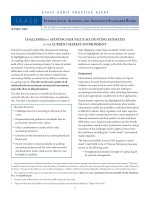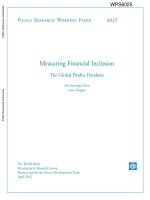the global business environment doc
Bạn đang xem bản rút gọn của tài liệu. Xem và tải ngay bản đầy đủ của tài liệu tại đây (238.52 KB, 21 trang )
The Global Business Environment
The Global Business Environment
International Strategy Formulation
•
Why Globalize?
–
expand sales
•
when domestic markets are saturated, should go
overseas to increase sales and profits
–
acquire resources
•
resources may be more readily available and less
costly in other countries
–
diversify sources of sales and supplies
•
different business cycles between countries
•
may avoid impact of price swings or shortages
–
avoid tariffs
The Changing Global Environment
•
In the past, managers have viewed the global sector as
closed
–
Each country or market was assumed to be isolated from
others
–
Firms did not consider global competition, exports
•
Today’s business environment is very different
–
Managers need to view it as an open market
–
Organizations buy and sell around the world
–
Managers need to learn to compete globally
•
Global organizations
–
organizations that operate and compete in more than one
country
–
are free to establish foreign subsidiaries to become strong
world competitors
Barriers to Free Trade
Free Trade
Barriers
Tariffs
Economic
Communities
Export
Restraints
Buy National
Campaigns
Quotas
Local Ownership
Requirements
Distance
Cultural
Differences
Barriers to International Trade
•
Trade Controls - governmental influences usually
aimed at reducing the competitiveness of imported
products or services
–
Tariffs: taxes levied on goods shipped
internationally
–
Subsidies: direct payments to domestic producers
–
Quotas: legal restrictions on the import of goods
•
Free trade doctrine - predicts that if each country
agrees to specialize in the production of goods that it
can produce most efficiently, it will
–
make the best use of global resources
–
result in lower prices
Distance and Cultural Barriers
•
Distance and Cultural barriers also “closed” the global
environment
–
Distance closed the markets as far as some managers
were concerned
–
Communications could be difficult
–
Languages and cultures were different
•
During the last 50 years, communications and
transportation technology has dramatically improved
–
Jet aircraft, fiber optics, satellites have provided fast,
secure communications and transportation
–
These have also reduced cultural differences
Effects of Free Trade on Managers
•
Declining barriers have opened great opportunities for
managers.
–
Managers can not only sell goods and services but also
buy resources and components globally.
•
Managers now face a more dynamic and exciting job due
to global competition.
Global Task Environment
Suppliers
Distributor
s
Customers
Competitors
Forces Yielding
Opportunities
and Threats
Suppliers & Distributors
•
Managers buy products from global suppliers or make
items abroad and supply themselves
–
Key is to keep quality high and costs low
•
Global outsourcing: firms buy inputs from throughout
the world
–
GM might build engines in Mexico, transmissions in
Korea, and seats in the U.S.
–
Finished goods become global products
•
Distributors: each country often has a unique system of
distribution
–
Managers must identify all the issues
Customers & Competitors
•
Formerly distinct national markets are merging into a
huge global market
–
True for both consumer and business goods
–
Creates large opportunities
•
Still, managers often must customize products to fit
the culture
–
McDonald's sells a local soft drink in Brazil
•
Global competitors present new threats
–
Increases competition abroad as well as at home.
Forces in the Global General Environment
Political &
Legal Systems
Economic
system
Sociocultural
System
Forces yielding
Opportunities
and threats
Political/Legal Environment
•
Different legal systems: common law or civil law
–
Representative democracies: such as the U.S., Britain, and
Canada
•
Citizens elect leaders who make decision for electorate.
•
Usually has a number of safeguards such as freedom of
expression, a fair court system, regular elections, and limited
terms for officials
•
Well-defined legal system and economic freedom
–
Totalitarian regimes: a single political party or person
monopolize power in a country
•
Typically do not recognize or permit opposition
•
Do not have most safeguards found in a democracy
•
Difficult to do business with given the lack of economic
freedom
•
Human rights issues also cause managers to avoid dealing
with these countries
Economic Environment
Economic Systems
•
Market Economy
–
production and prices are dictated by supply and
demand
–
production of goods and services is privately owned
–
competitive markets
–
strong currencies
–
institutional support
–
well-functioning infrastructures
–
investment opportunities for individuals
–
social welfare, consumer-directed,
administratively guided
Economic Environment
Command Economy
–
government sets goals and determines the price
and quantity of what is produced
–
most command economies are moving away from
the command economic system
•
Mixed Economy
–
certain economic sectors controlled by private
business, while others are government controlled
–
many mixed countries are moving toward a free
enterprise system
•
Key Economic Issues (and indicators)
–
economic growth, inflation, quality of life, GDP
–
exchange rates
International Strategy Formulation
How Do Organizations Globalize?
Stage One: Passive Response
Importing: firm makes products and sells abroad
Exporting: to foreign countries
Stage Two: Initial (Overt) Entry
Hiring foreign representation
Contracting with foreign manufacturers
Stage Three: Fully-established operations
Licensing/Franchising
Foreign Direct Investment (FDI)
- Joint Ventures
- Foreign Subsidiary
International Strategy Formulation
•
Exporting: selling abroad, either directly to target
customers or indirectly by retaining foreign sales
agents and distributors
•
Importing: selling other countries products in the
home country, either directly to target customers or
indirectly
Adv: quick and relatively inexpensive
test the waters and learn about
customers
Disadv: high transportation costs
tariffs and quotas
danger of poor intermediary selection
International Strategy Formulation
•
Licensing: an arrangement where a firm (licensor)
grants a foreign firm the right to use intangible
(“intellectual”) property such as patents, copyrights,
manufacturing processes, or trade names for a
specified period of time, usually in return for a
percentage of the earnings, called royalty
Adv: small or insignificant investment
Disadv: loss of control
International Strategy Formulation
•
Franchising: an arrangement where a parent
company (franchisor) grants a foreign firm
(franchisee) the right to do business in a
prescribed manner. Usually involves a longer time
commitment by both parties than required under
licensing agreements
Adv: small or insignificant investment
Disadv: loss of quality control
International Strategy Formulation
•
Foreign Direct Investment:
operations in one country that are controlled by
entities in a foreign countries
–
acquiring control by owning more than 50 percent
of the operation
–
turns a firm into a multinational enterprise
Foreign Direct Investment
•
Strategic Alliance:
–
a cooperative agreement between potential or
actual competitors
–
an agreement between firms that is of strategic
importance to one or both firms; competitive
viability
•
Joint Venture:
–
the participation of two or more companies jointly
in an enterprise in which each party contributes
assets, owns the entity to some degree, and
shares risk
•
Wholly Owned Foreign Subsidiaries
–
provide for tightest controls by foreign firms
–
very costly but can yield high returns
International Expansion
Importing
Exporting
Licensing
Franchising
Joint Ventures
Strat. Alliances
Wholly-
owned For.
Subsidiary
Low
High
Level of Foreign involvement and investment
needed by a global organization









